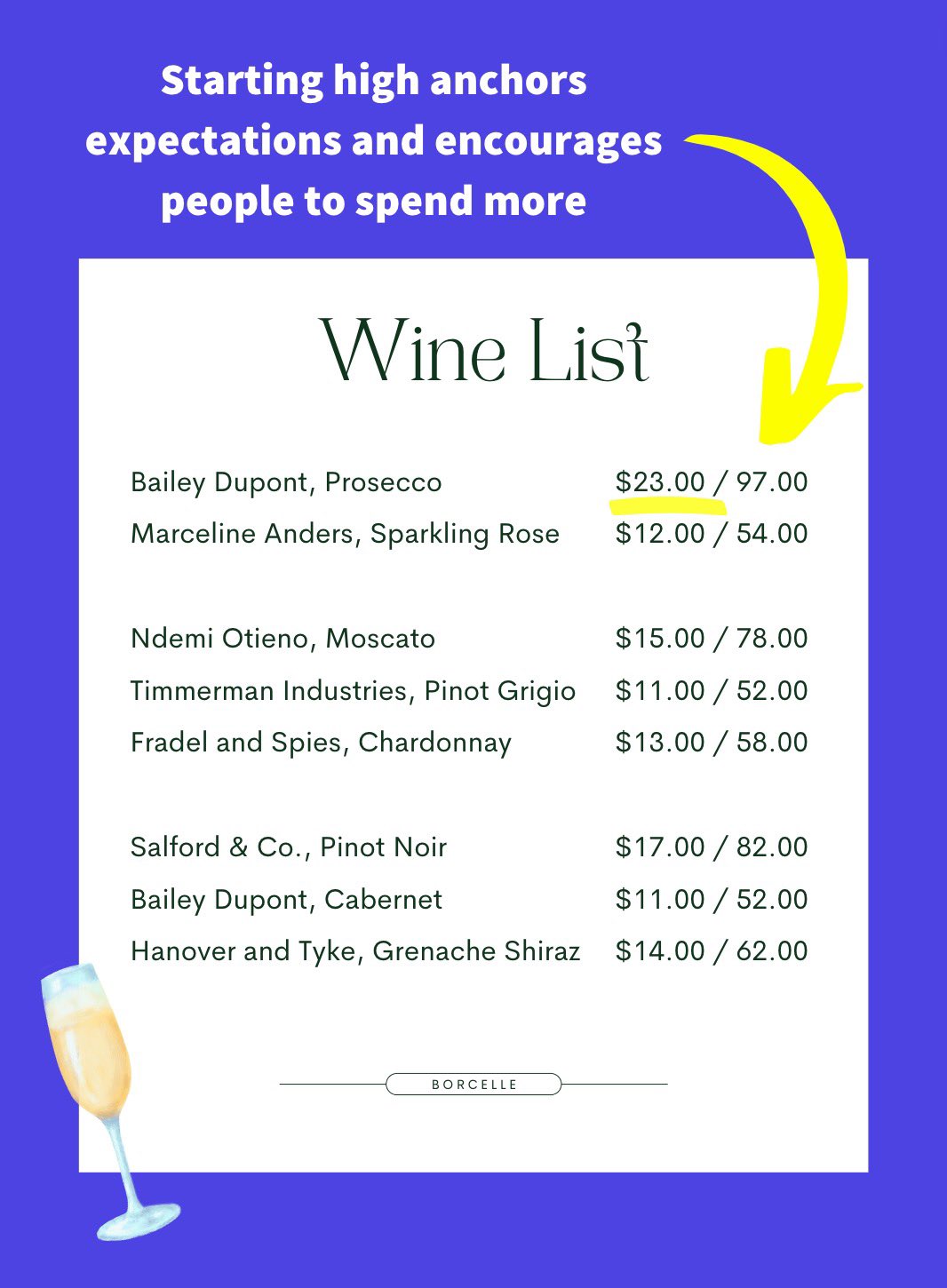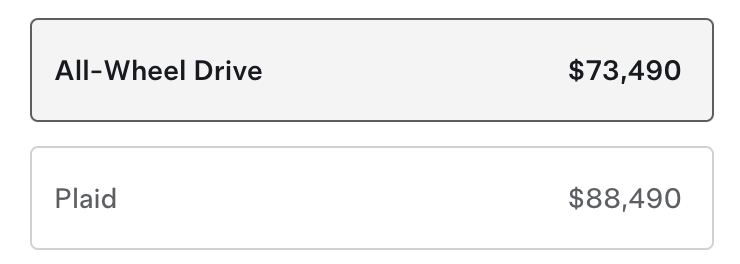The Growth Newsletter #233 |
12 Pricing Psychology Tips |
| |
We are not rational. We don’t just evaluate the price of a product by itself. How it’s presented significantly impacts how we interpret it. Let's dive into some actionable pricing tips 🧠 Neal |
|
|
Brought to you by Attio—an AI-native CRM that powers ambitious builders of the future.
It’s flexible, easily configures to your unique data structures, and scales companies from seed stage to category leader.
Attio automatically enriches your contacts, syncs your emails and calendar, gives you powerful reports, & lets you quickly build AI-powered automations. The next era of companies deserves a CRM built for the future. Join ElevenLabs, Replicate, Modal, and more.
Try Attio for free today. |
|
|
Want to be featured in front of over 90,000 founders and marketers? Learn more here. |
Your price and how you present it are huge.
Here are 12 tips (lovingly acquired from Katelyn Bourgoin) on how to present prices/numbers so they appear either big or small (depending on your goal) 1. Big Font = Big Price
Brains are lazy. When we see a big thing, we associate it with bigness. When we see a small thing, we associate it with smallness. So a big font = big price. Small font = small price. |
|
|
If you want a price to seem small, make it small. If you want a number (like social proof) to seem big, make it big. |
|
|
2. Dollar signs can trigger “pain of paying”
Paying for things hurts. Paying with a card is less painful than handing over cash. |
|
|
Leaving off the dollar sign can reduce the association between the pain of paying and the price. |
|
|
3. & 4. Exact numbers appear larger. Abbreviated numbers appear smaller Which feels bigger? Or even: - A grand
- One thousand dollars
|
|
|
If you want a number to feel BIG (competitor’s price or social proof), streeeeeeeeeeetch it out with commas and decimals. If you want a number to feel small (your price), abbreviate it. |
|
|
5. The first number is the point of comparison
If you open a wine list and the first bottle is a Bordeaux that costs $4,800, then the $20 glass of local red wine seems like a steal. If you first see the $10 glass of red house at the top of the wine list, then the $20 glass seems pricey.
|
|
|
List higher priced items first to encourage people to spend more. |
|
|
6. Numbers in red feel like a bargain Over the years, we’ve been conditioned to associate red with bargains and sales. |
|
|
7. Numbers that end in 99 appear cheaper
This is a retail classic. It’s not $6.00 but $5.99. Hell, even car companies do it with financing/leasing costs: |
That’s because you see the 2 in front and think, “It’s only $200!” This is a mistake I’ve heard my mom make countless times. This old trick is called “charm pricing.” |
|
|
Consider using charm pricing to appear low-cost.
Doing $.99 makes it appear cheap, so Tesla removes decimals on leases ($299). On the car price, they distance away from “cheapness” even further by doing $73,490 instead of $73,499 or $73,499.99. |
|
|
8. Odd numbers appear cheaper than even ones Here’s an odd one.
For some reason, our brains interpret odd numbers as lower than even ones. So $120 seems significantly more expensive than $117 or $119. |
|
|
End prices with an odd number to appear smaller (without looking cheap) |
|
|
9. Round numbers = more expensive
Charm pricing and exact numbers are classics for budget options—it makes them appear low-cost and that the price is chosen based on margins/costs. So, what do luxury brands do?
They use round numbers to signify, “Our product is worth what it’s worth.” |
|
|
Use round numbers to sell luxury. |
|
|
10. Specific numbers anchor expectations
If your agency does projects ranging from $1,000 to $100,000. If you say “starting at $1,000” then a lead will be really shocked if you quote $50,000 for a project. This is also true for quantities! Snickers grew sales by 38% simply by changing the anchor from ‘them’ to ‘18.’ Suddenly, buying a handful of Snickers at once became socially acceptable instead of just one. |
|
|
Be careful how you anchor with prices or anchors.
|
|
|
11. Comparisons help us decide
Whenever we see a price, we want to compare it to something else to make sure we’re getting a decent deal.
Which is what was clever about Basecamp’s old pricing that showed the cost of all the software you’d need to use instead: |
Tesla also loves to include “gas savings” into the price estimate: |
|
|
Strategically compare your cost against competitors to make yourself look like a deal. |
|
|
12. We’ll buy more to get something for $0 If given the choice between “Buy One Get One Free” or “50% off when you buy 2,” the BOGO offer is more compelling even though they’re the same thing. In other words, we’d rather feel like we’re getting the second pair for free than getting both pairs for half off.
Silly brains. This is why “free shipping for orders over $100” is so powerful—even though we’re buying more than we intended. |
|
|
Free bonuses often beats discounts. |
|
|
Spend some time rethinking your product/service's price and presentation. They can greatly impact how your leads react to it. |
| |
What did you think of today's newsletter? |
😍 Loved it: Forward to a friend, or reply—a simple 😍 will do! It really helps.
🤷♀️ Meh: You can unsubscribe here, or manage your subscription here. 🤔 I'm new here: You can join the party here.
🤩 Give me more: Check out all previous growth tactics in our Growth Vault.
|
|
|
-
Read our free playbooks, articles, growth guide, and teardowns—we break down the strategies & tactics used by fast-growing
startups.
-
Enroll in the best (and last) cohort of UNIGNORABLE. Our popular audience build cohort whose alumni have over 4M followers today.
-
Need help running ads? We’ve built the ads agency for startups.
Looking for a growth freelancer or agency? We’ll match you with a vetted partner for free.
Get in front of 101,000+ founders by sponsoring this newsletter.
|
|
|
© 2025 Demand Curve, Inc. All rights reserved. 4460 Redwood Hwy, Suite 16-535, San Rafael, California, United States
Unsubscribe from all emails, including the newsletter, or manage subscription preferences. |
|
|
|


_01JHGKK73CRX1PXY0RFFDJC2EM.jpg)

_01JHGKV8BRF7BPMDD26Y66P08Z.jpg)

_01JHGM1550T1TA4PQ1WCKH9GEZ.jpg)
_01JHGM47410VSD5FQWHAEWGM2X.jpg)
_01JHGM6F7GJGBHXEQKQ6AWW94D.jpg)




